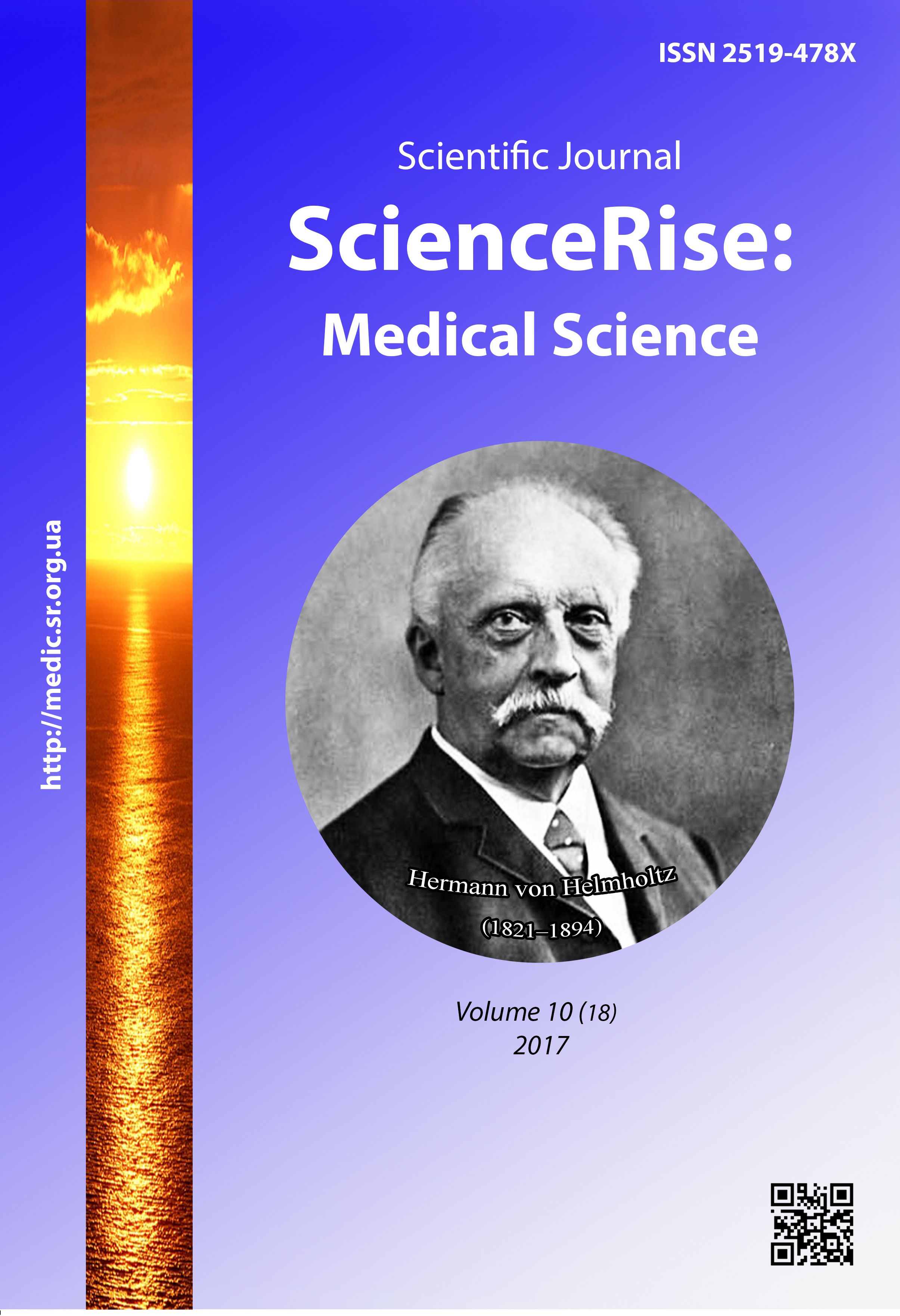Определение возможности развития угрожающего состояния у пациентов с диабетическим кетоацидозом
DOI:
https://doi.org/10.15587/2519-4798.2017.113321Ключові слова:
диабетический кетоацидоз, интенсивная терапия, энтеральная оксигенация, гепато-интестинальная дисфункция, логистическая регрессияАнотація
Исследование посвящено определению возможности развития угрожающего состояния у больных с диабетическим кетоацидозом. Разработана математическая модель прогнозирования риска развития гепато-интестинальной дисфункции/недостаточности. Полученные результаты математического моделирования могут быть использованы для углублённого понимания наиболее значимых патологических процессов у больных с диабетическим кетоацидозом, что позволит на более ранних сроках начинать их профилактику и лечение
Посилання
- Pertzeva, N., Mankovsky, B. (2015). The slow Progression of type 1 Diabetes as Part of autoimmune Polyendocrine syndrome type 2. Diabetes Case Studies: Real Problems, Practical Solutions, 153–155.
- Diabetes. Media centre WHO (2017). WHO. Available at: http://www.who.int/mediacentre/factsheets/fs312/en/
- Dedov, I. I., Shestakova, M. V. (2003). Sakharnyy diabet [Diabetes mellitus]. Moscow: Universum Pablishing, 455.
- Mankovsky, B. N. (2004). Neotlozhnye sostoyanyya pry sakharnom dyabete [Emergency states in diabetes mellitus]. The art of treatment, 9, 86–91.
- Smirnova, O. O. (2015). Diabeticheskiy ketoatsidoz. Chast 2. Podkhod k stabilizatsii «nestabilnogo» diabetika [Diabetic ketoacidosis. Part 2. Approach to stabilizing the "unstable" diabetic]. Endocrinology, 4 (26), 48–56.
- Kiryanov, B. F., Tokmachev, M. S. (2009). Matematicheskie modeli v zdravookhranenii [Mathematical Models in Health Care]. Velikiy Novgorod: Novgorod State University, 279.
- Kolbin, A. S., Kurylev, A. A., Proskurin, M. A., Balykina, Yu. Ye. (2012). Modelirovanie meditsinskikh i ekonomicheskikh iskhodov sakharnogo diabeta [Simulation of medical and economic outcomes of diabetes mellitus]. Clinical pharmacology and therapy, 21 (5), 91–96.
- Stratton, I. M. (2000). Association of glycaemia with macrovascular and microvascular complications of type 2 diabetes (UKPDS 35): prospective observational study. BMJ, 321 (7258), 405–412. doi: 10.1136/bmj.321.7258.405
- Clarke, P., Gray, A., Holman, R. (2002). Estimating Utility Values for Health States of Type 2 Diabetic Patients Using the EQ-5D (UKPDS 62). Medical Decision Making, 22 (4), 340–349. doi: 10.1177/0272989x0202200412
- Clark, L. T. (2003). Treating dyslipidemia with statins: The risk-benefit profile. American Heart Journal, 145 (3), 387–396. doi: 10.1067/mhj.2003.70
- Goodall, G., Jendle, J. H., Valentine, W. J., Munro, V., Brandt, A. B., Ray, J. A. et. al. (2008). Biphasic insulin aspart 70/30 vs. insulin glargine in insulin naïve type 2 diabetes patients: modelling the long-term health economic implications in a Swedish setting. International Journal of Clinical Practice, 62 (6), 869–876. doi: 10.1111/j.1742-1241.2008.01766.x
- Mueller, E., Maxion-Bergemann, S., Gultyaev, D., Walzer, S., Freemantle, N., Mathieu, C. et. al. (2006). Development and Validation of the Economic Assessment of Glycemic Control and Long-Term Effects of Diabetes (EAGLE) Model. Diabetes Technology & Therapeutics, 8 (2), 219–236. doi: 10.1089/dia.2006.8.219
- Serdyukova, D. M. (2015). Vliyanie stoimosti bolezni na optimalnyy vybor farmakoterapii sakharnogo diabeta 2 tipa [Influence of cost of illness to optimal choice of pharmacotherapy for type 2 diabetes]. Volgograd, 24.
- Aleksandrovich, Yu. S., Gordeev, V. I. (2010). Otsenochnye i prognosticheskie shkaly v meditsine kriticheskikh sostoyaniy [Estimating and prognostic scales in the medicine of critical states]. Sankr-Peterburg: Publishing house "ELBI-SPb", 248.
- Kurnikova, I. A. (2010). Optimizatsiya sistemnogo podkhoda v reabilitatsii bolnykh s sakharnym diabetom s vysokoy komorbidnostyu [Optimization of the system approach in the rehabilitation of patients with diabetes with high comorbidity]. Ulyanovsk, 48.
- Klimenteva, G. I., Kurnikova, I. A., Kuznetsova, I. A., Afonova, T. M. (2012). Sakharnyy diabet 2-go tipa i problema komorbidnoy patologii [Diabetes mellitus type 2 and the problem of comorbid pathology]. Kuban scientific medical bulletin, 1. Available at: http://cyberleninka.ru/article/n/saharnyy-diabet-2-go-tipa-i-problema-komorbidnoy-patologii
- Atramentova, L. A., Kravchun, N. A., Poltorak, V. V., Gorshunskaya, M. Yu., Yensen, Ye. et. al. (2015). Otsenka riska razvitiya nealkogolnoy zhirovoy bolezni pecheni u bolnykh sakharnym diabetom 2 tipa po sochetannomu patternu retinol svyazuyushchego proteina-4, adiponektina vysokogo molekulyarnogo vesa i indeksa massy tela [Assessment of the risk of developing non-alcoholic fatty liver disease in patients with type 2 diabetes mellitus according to the combined pattern of retinol binding protein-4, adiponectin of high molecular weight and body mass index]. Problems of endocrine pathology, 3, 15–23.
- Lysenko, V. Y., Bryk, R. P., Karpenko, Ye. O. (2016). Korektsiya dyz·hidriyi ta hepato-intestynal'noyi dysfunktsiyi u khvorykh z diabetychnym ketoatsydozom [Correction of dihydrogen and hepato-intestinal dysfunction in patients with diabetic ketoacidosis]. Problems of Continuous Medical Education and Science, 1 (21), 73–78.
- Georgiyants, M. A., Pushkar, M. B., Vysotska, O. V., Porvan, A. P. (2017). Optimization of postoperative analgesia after adenoidectomy in children. Regulatory Mechanisms in Biosystems, 8 (2), 277–282. doi: 10.15421/021743
- Shulika, B., Porvan, A., Vysotska, O., Nekos, A., Zhemerov, A. (2017). Control over grape yield in the north-eastern region of Ukraine using mathematical modeling. Eastern-European Journal of Enterprise Technologies, 2 (3 (86)), 51–59. doi: 10.15587/1729-4061.2017.97969
- Georgiyants, M., Khvysyuk, O., Boguslavskaуa, N., Vysotska, O., Pecherska, A. (2017). Development of a mathematical model for predicting postoperative pain among patients with limb injuries. Eastern-European Journal of Enterprise Technologies, 2 (4 (86)), 4–9. doi: 10.15587/1729-4061.2017.95157
- Davis, J., Goadrich, M. (2006). The relationship between Precision-Recall and ROC curves. Proceedings of the 23rd international conference on Machine learning. Available at: http://pages.cs.wisc.edu/~jdavis/davisgoadrichcamera2.pdf
##submission.downloads##
Опубліковано
Як цитувати
Номер
Розділ
Ліцензія
Авторське право (c) 2017 Ruslan Bryk, Viktor Lysenko, Olena Vysotska, Andrei Porvan

Ця робота ліцензується відповідно до Creative Commons Attribution 4.0 International License.
Наше видання використовує положення про авторські права Creative Commons CC BY для журналів відкритого доступу.
Автори, які публікуються у цьому журналі, погоджуються з наступними умовами:
1. Автори залишають за собою право на авторство своєї роботи та передають журналу право першої публікації цієї роботи на умовах ліцензії Creative Commons CC BY, котра дозволяє іншим особам вільно розповсюджувати опубліковану роботу з обов'язковим посиланням на авторів оригінальної роботи та першу публікацію роботи у цьому журналі.
2. Автори мають право укладати самостійні додаткові угоди щодо неексклюзивного розповсюдження роботи у тому вигляді, в якому вона була опублікована цим журналом (наприклад, розміщувати роботу в електронному сховищі установи або публікувати у складі монографії), за умови збереження посилання на першу публікацію роботи у цьому журналі.










